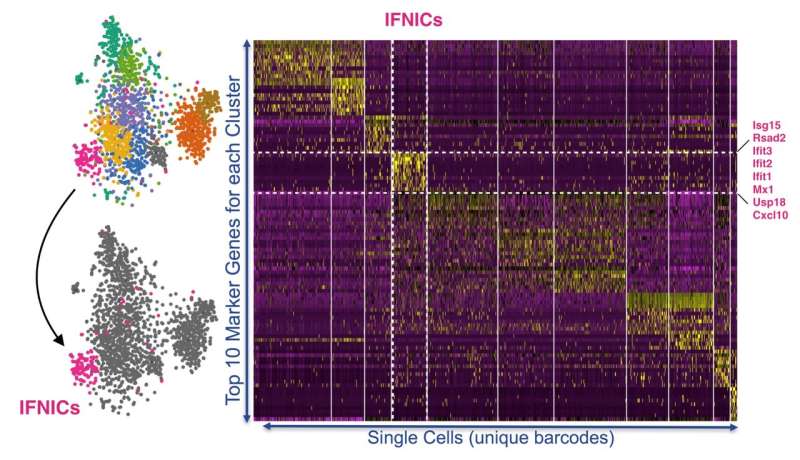Immune cells mistake heart attacks for viral infections

A study led by Kevin King, a bioengineer and physician at the University of California San Diego, has found that the immune system plays a surprising role in the aftermath of heart attacks. The research could lead to new therapeutic strategies for heart disease.
The team, which also includes researchers from the Center for Systems Biology at Massachusetts General Hospital (MGH), Brigham and Women's Hospital, Harvard Medical School, and the University of Massachusetts, presents the findings in the Nov. 6 issue of Nature Medicine. Ischemic heart disease is the most common cause of death in the world and it begins with a heart attack. During this process, heart cells die, prompting immune cells to enter the dead tissue, clear debris and orchestrate stabilization of the heart wall.
But what is it about dying cells in the heart that stimulates the immune system? To answer this, researchers looked deep inside thousands of individual cardiac immune cells and mapped their individual transcriptomes using a method called single cell RNA-Seq. This led to the discovery that after a heart attack, DNA from dying cells masquerades as a virus and activates an ancient antiviral program called the type I interferon response in specialized immune cells. ¬¬ The researchers named these "interferon inducible cells (IFNICs)."
When investigators blocked the interferon response, either genetically or with a neutralizing antibody given after the heart attack, there was less inflammation, less heart dysfunction, and improved survival. Specifically, blocking antiviral responses in mice improved survival from 60 percent to over 95 percent. These findings reveal a new potential therapeutic opportunity to prevent heart attacks from progressing to heart failure in patients.
"We are interested to learn whether interferons contribute to adverse cardiovascular outcomes after heart attacks in humans," said King, who did most of the work on the study while he was a cardiology fellow at Brigham and Women's Hospital and at the Center for Systems Biology at MGH in Boston.
The immune system has evolved innate antiviral programs to defend against a diverse range of invading pathogens. Immune cells do this by detecting molecular fingerprints of pathogens, activating a protein called IRF3, and secreting interferons, which orchestrate a defense program mediated by hundreds of interferon-stimulated genes. Investigators found that surprisingly, the antiviral interferon response is also turned on after a heart attack despite the absence of any infection. Their results point to dying cell DNA as the cause of this confusion because the immune system interprets it as the molecular signature of a virus.
Surprisingly, the immune cells participating in the interferon response were a previously unrecognized subset of cardiac macrophages. These cells could not be identified by conventional flow sorting because unique markers on the cell surface were not known. By using single cell RNA Seq, an emerging technique that combines microfluidic nanoliter droplet reactors with single cell barcoding and next generation sequencing, the researchers were able to examine expression of every gene in over 4,000 cardiac immune cells and found the specialized IFNIC population of responsible cells.
Future studies will aim to better understand the interferon response and the IFNIC cell type and explore their roles in the infarcted and remodeling heart. The team is also working to understand the interferon response in other tissues and diseases where cell death occurs.
More information: IRF3 and type I interferons fuel a fatal response to myocardial infarction, Nature Medicine (2017). nature.com/articles/doi:10.1038/nm.4428


















